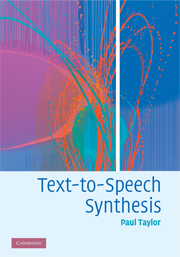Book contents
- Frontmatter
- Contents
- Foreword
- Preface
- 1 Introduction
- 2 Communication and language
- 3 The text-to-speech problem
- 4 Text segmentation and organisation
- 5 Text decoding: finding the words from the text
- 6 Prosody prediction from text
- 7 Phonetics and phonology
- 8 Pronunciation
- 9 Synthesis of prosody
- 10 Signals and filters
- 11 Acoustic models of speech production
- 12 Analysis of speech signals
- 13 Synthesis techniques based on vocal-tract models
- 14 Synthesis by concatenation and signal-processing modification
- 15 Hidden-Markov-model synthesis
- 16 Unit-selection synthesis
- 17 Further issues
- 18 Conclusion
- Appendix A Probability
- Appendix B Phone definitions
- References
- Index
2 - Communication and language
Published online by Cambridge University Press: 25 January 2011
- Frontmatter
- Contents
- Foreword
- Preface
- 1 Introduction
- 2 Communication and language
- 3 The text-to-speech problem
- 4 Text segmentation and organisation
- 5 Text decoding: finding the words from the text
- 6 Prosody prediction from text
- 7 Phonetics and phonology
- 8 Pronunciation
- 9 Synthesis of prosody
- 10 Signals and filters
- 11 Acoustic models of speech production
- 12 Analysis of speech signals
- 13 Synthesis techniques based on vocal-tract models
- 14 Synthesis by concatenation and signal-processing modification
- 15 Hidden-Markov-model synthesis
- 16 Unit-selection synthesis
- 17 Further issues
- 18 Conclusion
- Appendix A Probability
- Appendix B Phone definitions
- References
- Index
Summary
Before delving into the details of how to perform text-to-speech conversion, we will first examine some of the fundamentals of communication in general. This chapter looks at the various ways in which people communicate and how communication varies depending on the situation and the means which are used. From this we can develop a general model, which will then help us specify the text-to-speech problem more exactly in the following chapter.
Types of communication
We experience the world though our senses and we can think of this as a process of gaining information. We share this ability with most other animals: if an animal hears running water it can infer that there is a stream nearby; if it sees a ripe fruit it can infer that there is food available. This ability to extract information from the world via the senses is a great advantage in the survival of any species. Animals can, however, cause information to be created: many animals make noises, such as barks or roars, or gestures such as flapping or head nodding, which are intended to be interpreted by other animals. We call the process of deliberate creation of information with the intention that it be interpretedcommunication.
The prerequisites for communication are an ability to create information in one being, an ability to transmit this information and an ability to perceive the created information by another being.
- Type
- Chapter
- Information
- Text-to-Speech Synthesis , pp. 8 - 25Publisher: Cambridge University PressPrint publication year: 2009
- 1
- Cited by



